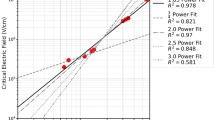Abstract
Failure analysis of ultra-bright LED arrays under varying degrees of electrical stress was performed. Green (565 nm), red (660 nm) and infrared (890 nm) LEDs were subjected to currents between 0 and 1 A and voltages between 0 and 7 V. Using white beam synchrotron X-ray topography (SXRT) in back reflection large-area and section modes, the failure modes of the devices were observed. As the power to each device was increased, a reduction in the definition of device lattice structure due to increased thermal stressing was observed. An increase in strain is witnessed in the devices as they are stressed to the point of near failure. It was noted that at or near failure, the strain fields in the ball-bonded regions of the device become anomalously large (0.08% for the red LED, 0.19% for the green LED and 0.27% for the infrared LED), as observed via orientational contrast on the topographs. This is most likely due to thermally induced damage. The onset of failure took place when the power supplied to each individual LED exceeded 600 mW in the case of the green LEDs, 500 mW for the red LEDs and 745 mW for the infrared LEDs. Surprisingly, this is approximately 25 times greater than the nominal recommended supply for each LED array. This was confirmed by studying the I –V characteristics of the devices in conjunction with their emission spectra. As the power supplied to the devices was increased a narrowing of the radiative bandgap was witnessed in the red and green LEDs; whereas a broadening occurred in the infrared LED. When complete failure occurred in the samples, it was observed that large lattice deformations of the original device structure took place. Optical micrographs indicated that the structure of the devices remains spatially unaltered although the gold bond wire became detached. This confirmed that the distortion observed in the X-ray topographs is mainly due to severe thermally induced lattice distortion. The induced lattice distortion is greatest for the red LEDs; the sample appears to possess distinct and completely misorientated sub-grains.
Similar content being viewed by others
References
U. Zeimer, T. Baumbach, J. Grenzer, D. Lubbert, A. Mazuelas, U. Pietsch and G. Erbert, J. Phys. D: Appl. Phys. 32 (1999) A123.
T. Tuomi, K. Naukkarinen and P. Rabe, Phys. Status Solidi A 25 (1974) 93.
P. J. McNally, A. N. Danilewsky, J. W. Curley, A. Reader, R. RantamÄki, T. Tuomi, M. Bolt and M. Taskinen, Microelec. Eng. 45 (1999) 47.
R. RantamÄki, T. Tuomi, Z. R. Zytkiewicz, P. J. McNally and A. N. Danilewsky, J. X-Ray Sci. Technol. 2000.
D. K. Bowen and B. K. Tanner, in “High Resolution X-Ray Diffractometry and Topography,” (Taylor and Francis, 1998) pp. 173-174, pp. 233–234.
P. J. McNally, J. W. Curley, M. Bolt, A. Reader, T. Tuomi, R. RantamÄki, A. N. Danilewsky and I. deWolf, J. Mater. Sci. 10 (1999) 351.
E. Prieur, T. Tuomi, J. Partanen, E. Yli-Juuti and M. Tilli, J. Cryst. Growth 132 (1993) 599.
H. Kalt and M. Rinker, Phys. Rev. B 45 (1992) 1139.
Author information
Authors and Affiliations
Rights and permissions
About this article
Cite this article
Lowney, D., McNally, P.J., O'Hare, M. et al. Examination of the structural and optical failure of ultra-bright LEDs under varying degrees of electrical stress using synchrotron X-ray topography and optical emission spectroscopy. Journal of Materials Science: Materials in Electronics 12, 249–253 (2001). https://doi.org/10.1023/A:1011263404631
Issue Date:
DOI: https://doi.org/10.1023/A:1011263404631




